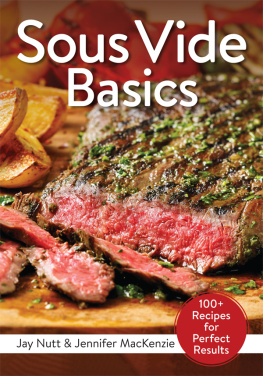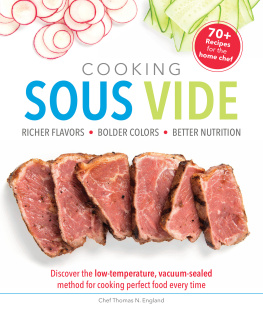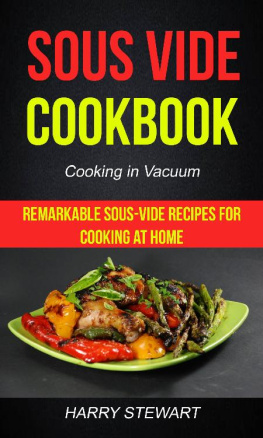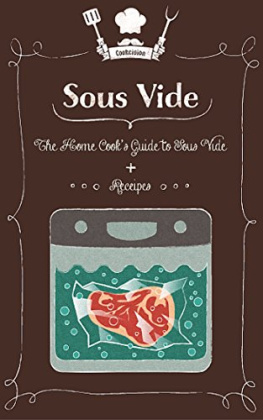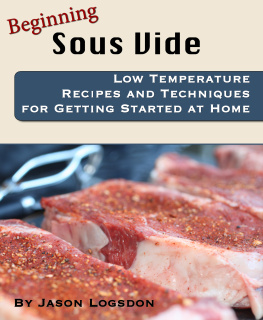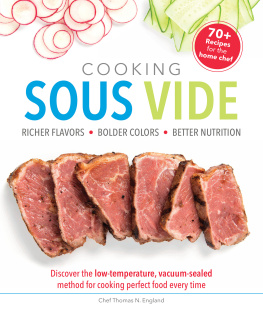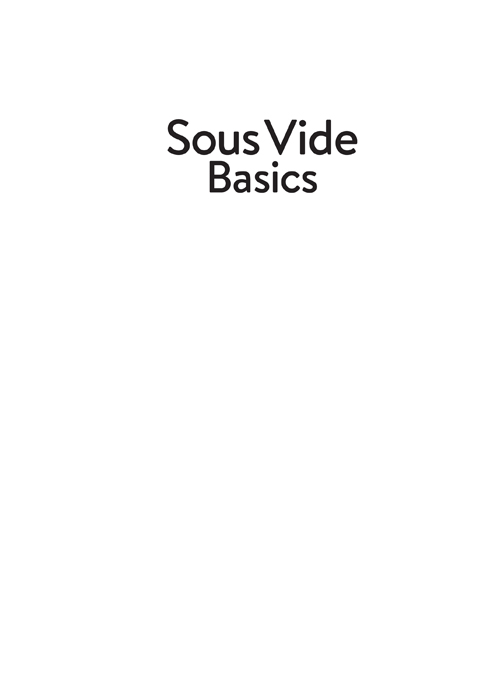
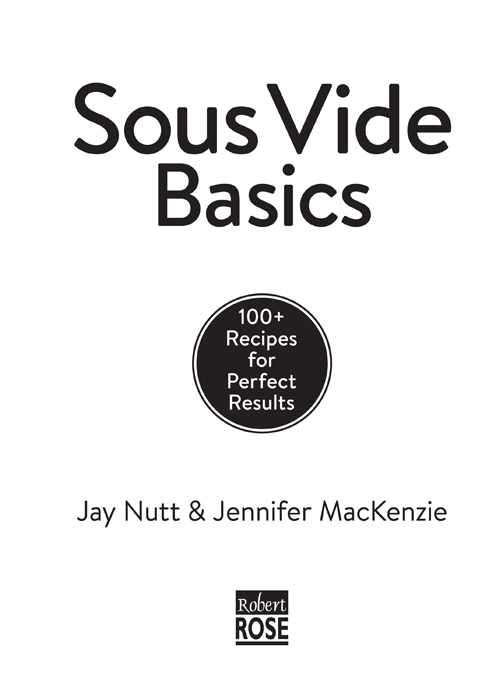
Sous Vide Basics
Text copyright 2017 Jay Nutt and Jennifer MacKenzie
Photographs copyright 2017 Robert Rose Inc.
Cover and text design copyright 2017 Robert Rose Inc.
No part of this publication may be reproduced, stored in a retrieval system or transmitted, in any form or by any means, without the prior written consent of the publisher or a license from the Canadian Copyright Licensing Agency (Access Copyright). For an Access Copyright license, visit www.accesscopyright.ca or call toll-free: 1-800-893-5777.
Library and Archives Canada Cataloguing in Publication
Nutt, Jay, 1966-, author
Sous vide basics: 100+ recipes for perfect results / Jay Nutt & Jennifer MacKenzie.
Includes index.
ISBN 978-0-7788-0582-3 (softcover)
ISBN 978-0-7788-0649-3 (epub)
1. Sous-vide cooking. 2. Cookbooks. I. MacKenzie, Jennifer, author II. Title.
TX690.7.N88 2017 | 641.587 | C2017-903748-X |
Disclaimer
The recipes in this book have been carefully tested by our kitchen and our tasters. To the best of our knowledge, they are safe and nutritious for ordinary use and users. For those people with food or other allergies, or who have special food requirements or health issues, please read the suggested contents of each recipe carefully and determine whether or not they may create a problem for you. All recipes are used at the risk of the consumer. Consumers should always consult their sous vide manufacturers manual for recommended procedures and cooking times.
We cannot be responsible for any hazards, loss or damage that may occur as a result of any recipe use.
For those with special needs, allergies, requirements or health problems, in the event of any doubt, please contact your medical adviser prior to the use of any recipe.
Design and production: Kevin Cockburn/PageWave Graphics Inc.
Layout: Alicia McCarthy/PageWave Graphics Inc.
Editor: Sue Sumeraj
Proofreader: Kelly Jones
Indexer: Gillian Watts
Photographer: Matt Johannsson/Reflector Inc.
Food stylist: Michael Elliott
Prop stylist: Charlene Erricson
Cover image: Argentinian Flank Steak with Chimichurri ()
The publisher gratefully acknowledges the financial support of our publishing program by the Government of Canada through the Canada Book Fund.

Published by Robert Rose Inc.
120 Eglinton Avenue East, Suite 800, Toronto, Ontario, Canada M4P 1E2
Tel: (416) 322-6552 Fax: (416) 322-6936
www.robertrose.ca
Introduction
As a couple who also happen to be a long-time chef (Jay) and a professional home economist and food writer (Jennifer), we often receive questions from our friends and guests along the lines of How do you cook steaks/chops/fish like [insert the name of your favorite chef/author/ restaurant]? We usually gently suggest that it takes practice to learn how to handle the variables of focus, controlling heat and monitoring time. These variables can be affected by something as simple as a distracting phone call, a grease flare on a barbecue or an extra minute looking for that ingredient or item you swore was just right there.
But if somebody were to ask us that question now, wed immediately declare Sous vide! For many foods, sous vide cooking is the answer, allowing home cooks to achieve restaurant-quality results with little effort and eliminating much of the guesswork of cooking.
Sous vide translates from French as under vacuum. Food is placed raw into food-safe plastic bags or pouches, or glass jars or containers sometimes with flavoring agents, spices or marinades then vacuum-sealed to remove excess air and cooked in a heat-controlled water bath, generally at lower temperatures and for longer times than cooking methods that use traditional heat (oven, stovetop, grills and even slow cookers). The results? Food is cooked evenly, meats remain juicy, and tough cuts become tender but still retain some pink and loads of flavor.
Cooking sous vide gives you exacting control over heat, as most home sous vide devices now allow you to set the precise desired temperature to within half a degree. Home ovens, stovetops and barbecues are all susceptible to factors like seasonal weather conditions, room temperature, surges in electrical current or gas flow, and opening and closing of lids and oven doors. Sous vide creates a controlled cooking environment with fewer outside factors.
Its also a very forgiving technique that allows you to leave food cooking for minutes or even hours longer, without the risk of it becoming overcooked which can happen very quickly with other cooking methods. Certain foods, such as grains, rice and some meats, can get overcooked with sous vide if you leave them too long, but youre not going to ruin dinner should you take a phone call or forget to put a pot of water on to boil for the pasta.
Like braising, sous vide is ideal for tough foods that need a long cooking time to become tender. But sous vides advantage over braising is that you dont need to add liquid to help tenderize tough meats, so the food retains its natural, true flavor rather than tasting like the sauce it is cooked in. The same goes for poaching. Tender foods, such as fish and asparagus, that are often poached in liquid (water with aromatics or broth) become perfectly cooked, tender and moist when cooked sous vide, yet they dont lose any flavor to the liquid, since they are essentially poached in their own juices.
One of our most surprising discoveries while creating these recipes was the effects of sous vide cooking on chicken. All too often, chicken becomes dry when youve cooked it long enough for food safety. Or you struggle to get the thigh cooked through without overcooking the breast. Or the results are just plain rubbery. With sous vide, chicken is flavorful, evenly cooked and so juicy. It is literally falling-off-the-bone tender not something we commonly associate with chicken!
Sous vide requires your full attention only at the beginning and end of the process; other than keeping an eye on the water level, it is mainly hands-off during the cooking time. It gives you confidence that the food is properly cooked (no more guesswork or poking juicy steaks with forks) and the freedom to focus on planning and preparing the rest of the meal or to do something else entirely with your time. It helps guarantee even doneness throughout the dish, and the food tends to be more flavorful, as no juices are lost to evaporation. Many dishes require only a couple minutes of finishing in a hot pan, in the broiler or on your barbecue grill.
Weve discovered many uses for the sous vide, well beyond steak, and its not just for hard-core food science enthusiasts anymore. The convenience of the smaller appliances, especially those you can use in any heatproof vessel that holds water, makes it a great technique to add to your cooking repertoire. You can cook sous vide at home for everyday meals, in your RV, on a boat or at a cottage anywhere there is water and electricity, really and youll definitely want to use it to simplify your meal prep and dazzle your guests when entertaining.
Do read all of the how-tos and whys and get comfortable with The Basics (see ) by cooking a steak, a fish fillet or a simple piece of chicken. Before long, youll be creating perfectly cooked sous vide meals that just might have your family and friends calling you Chef.
Next page
